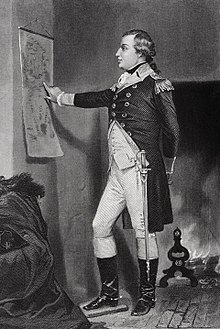Richard Montgomery | |
|---|---|
 Engraving of Montgomery by Alonzo Chappel | |
| Born | 2 December 1738 Feltrim, County Dublin, Kingdom of Ireland |
| Died | 31 December 1775 (aged 37) Quebec City, Province of Quebec, British America |
| Buried | Quebec City, Province of Quebec, British America (reinterred in 1818 to St. Paul's Churchyard, Manhattan, New York City) |
| Allegiance | |
| Service |
|
| Rank | Major general |
| Battles / wars | |
| Signature | |
Richard Montgomery (2 December 1738 – 31 December 1775) was an Irish-born American military officer who first served in the British Army. He later became a major general in the Continental Army during the American Revolutionary War, and he is most famous for leading the unsuccessful 1775 invasion of northeastern Quebec.
Montgomery was born and raised in Ireland to an Ulster-Scots family. In 1754, he enrolled at Trinity College, Dublin, and two years later joined the British Army to fight in the French and Indian War. He steadily rose through the ranks, serving in North America and the West Indies. After the war he was stationed at Fort Detroit during Pontiac's War, following which he returned to Britain for health reasons. In 1773, Montgomery returned to the Thirteen Colonies, married Janet Livingston, and began farming.
When the American Revolutionary War broke out, Montgomery took up the Patriot cause, and was elected to the New York Provincial Congress in May 1775. In June 1775, he was commissioned as a brigadier general in the Continental Army. After Philip Schuyler became too ill to lead the invasion of Canada, Montgomery took over. He captured Fort St. Johns and then Montreal in November 1775, and then advanced to Quebec City, where he joined another force under the command of Benedict Arnold. On 31 December, he led an attack on the city, but was killed during the battle. The British found his body and gave him an honorable burial. His remains were moved to New York City in 1818.
- ^ "Fairleigh Dickinson EDM". Archived from the original on 29 September 2008. Retrieved 1 September 2008.